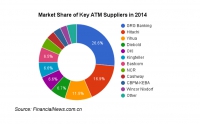China Banking Research
A whole generation of ordinary Chinese have been neglected in terms of wealth management and banking with high minimum investment thresholds or VIP-only products preventing only a select few from getting access to traditional wealth management products. Alibaba and Tencent have brought innovative internet finance based services such as Tenpay or Alipay to the market and have further opened up wealth management to an entire new segment of the market with 'mass-market' wealth management products. China’s e-commerce powerhouse Alibaba now is after banking industry.
A new partnership between CreditEase and Wellington has changed the rules with an incredibly easy way for the increasingly wealthy middle-class to invest abroad.
According to data from the People's Bank of China, by the end of 2014 China had 614,900 ATMs in operation across the country, up 18.25% from 2013. While certainly a rapid growth, it was actually slower than a year ago when the number of networked ATMs increased by 25.12%, and is significantly lower than its peak growth of 36.18% in 2008.
P2P woes continue in China as illegal fundraising through P2P platforms grew in both 2014 and 2015. When will the government intervene?
Accenture recently released its Accenture North America Consumer Digital Banking Survey for 2015. One of the findings was that banks run the risk of being seen as a 'utility' to their customers. Could the same thing happen in China?
Nearly done with banking and capital markets, China shifts its focus to opening up the insurance industry
You would be forgiven for missing the news with most of the focus this week on Shanghai's never ending stock market run or the latest mention of liberialization and opening in the bank card clearing market, but now it appears that the insurance industry will be the next segment of China's transforming financial industry to be opened up to competition.
It appears, as the WSJ reported, that the implementation of China's controversial banking technology rules has been paused for the moment. But what can we expect in the future?
How do foreign credit score and risk management companies fit into China’s shadow banking industry?
China's P2P industry, which is technically a shadow banking / lending channel, continued its explosive growth in 2014 as 1,200 new platforms launched and transaction volumes grew 2.39 times as compared to 2013. At the same time the number of platforms suffering serious problems was 275, up 260% from the year before.
China launches deposit insurance
Talked about for many years, one of the key reforms in China's outsized and ambitious plan is the launch of the deposit insurance program. An announcement yesterday confirmed that the program will finally launch in May.
P2P platform Lufax raises offshore capital, IPO planned
Shanghai based Lufax, one of China’s biggest P2P platforms, has just received a USD 483 million-worth investment from foreign institutional and private investors. Is the investment rearranging deck-chairs on a sinking ship or a clear signal that everything is fine in the troubled P2P industry?
More...
A few days ago, the upstart Chinese manufacturer of android-based smartphones Xiaomi launched a public beta of their new online money-market fund. With Chinese tech companies furiously investing in and creating platforms bundling key products and services together, could we see Xiaomi competing directly with Alipay and Wechat in the near future?
Chinese banks in 2014: another good year
The China Banking Regulatory Commission (CBRC) released its annual banking industry statistics for 2014. Banks accumulated RMB 172.3 trillion in assets, up 13.87% since 2013. The Big 5 large commercial banks had a slower growth rate than the joint-stock commercial banks, 8.25% and 16.50% respectively.
Will China skip the credit card revolution completely?
The recent PBOC annual Payments Industry Overview report shows plenty of impressive data and the main message that comes through is that "everything is growing". However, not all growth is the same and the numbers for credit cards industry are especially interesting.
Alibaba and Credit Scoring: More thoughts on Sesame Credit
Personal credit ratings in China have never been a pretty subject. Without a centralized credit database accessible to all, getting accurate credit information has proved challenging for any company in China providing loan products. With Ant Financial, the financial arm of Alibaba, launching Sesame Credit, we felt it was worth taking a second look at what might be happening here.





